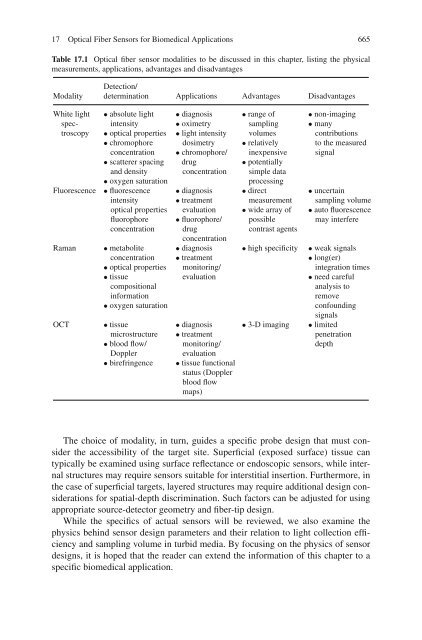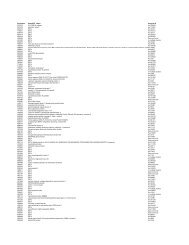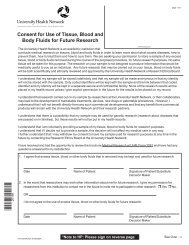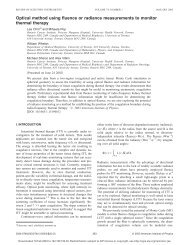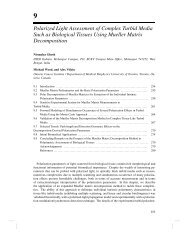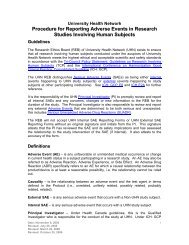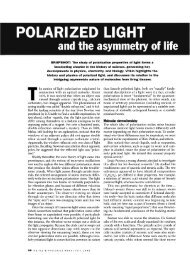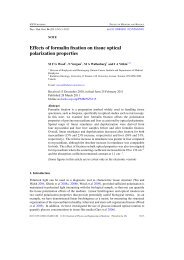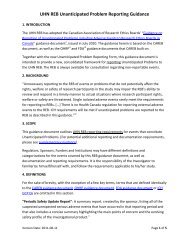Optical Fiber Sensors for Biomedical Applications
Optical Fiber Sensors for Biomedical Applications
Optical Fiber Sensors for Biomedical Applications
Create successful ePaper yourself
Turn your PDF publications into a flip-book with our unique Google optimized e-Paper software.
17 <strong>Optical</strong> <strong>Fiber</strong> <strong>Sensors</strong> <strong>for</strong> <strong>Biomedical</strong> <strong>Applications</strong> 665Table 17.1 <strong>Optical</strong> fiber sensor modalities to be discussed in this chapter, listing the physicalmeasurements, applications, advantages and disadvantagesModalityDetection/determination <strong>Applications</strong> Advantages DisadvantagesWhite lightspectroscopyFluorescenceRamanOCT• absolute lightintensity• optical properties• chromophoreconcentration• scatterer spacingand density• oxygen saturation• fluorescenceintensityoptical propertiesfluorophoreconcentration• metaboliteconcentration• optical properties• tissuecompositionalin<strong>for</strong>mation• oxygen saturation• tissuemicrostructure• blood flow/Doppler• birefringence• diagnosis• oximetry• light intensitydosimetry• chromophore/drugconcentration• diagnosis• treatmentevaluation• fluorophore/drugconcentration• diagnosis• treatmentmonitoring/evaluation• diagnosis• treatmentmonitoring/evaluation• tissue functionalstatus (Dopplerblood flowmaps)• range ofsamplingvolumes• relativelyinexpensive• potentiallysimple dataprocessing• directmeasurement• wide array ofpossiblecontrast agents• high specificity• 3-D imaging• non-imaging• manycontributionsto the measuredsignal• uncertainsampling volume• auto fluorescencemay interfere• weak signals• long(er)integration times• need carefulanalysis toremoveconfoundingsignals• limitedpenetrationdepthThe choice of modality, in turn, guides a specific probe design that must considerthe accessibility of the target site. Superficial (exposed surface) tissue cantypically be examined using surface reflectance or endoscopic sensors, while internalstructures may require sensors suitable <strong>for</strong> interstitial insertion. Furthermore, inthe case of superficial targets, layered structures may require additional design considerations<strong>for</strong> spatial-depth discrimination. Such factors can be adjusted <strong>for</strong> usingappropriate source-detector geometry and fiber-tip design.While the specifics of actual sensors will be reviewed, we also examine thephysics behind sensor design parameters and their relation to light collection efficiencyand sampling volume in turbid media. By focusing on the physics of sensordesigns, it is hoped that the reader can extend the in<strong>for</strong>mation of this chapter to aspecific biomedical application.


